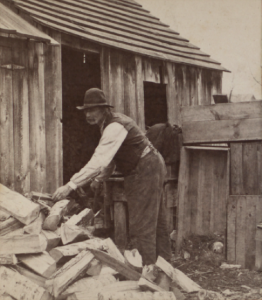On December 28, 1873, after a terrible economic recession descended on New York—bringing with it unemployment and eviction—the New York Times sounded the alarm on a new urban threat.
“At the present time there is supposed to be at least 3,000 vagrants in this City, while there is a large number who travel from place to place, either begging as they go along, or doing odd jobs for their meals,” warned the front page article.
 “These tramps are always pretending to look for work, but it is very rare that they will accept it if offered, unless to get a chance to steal something.”
“These tramps are always pretending to look for work, but it is very rare that they will accept it if offered, unless to get a chance to steal something.”
Tramps had arrived in New York—ragged, disconnected men who appeared on sidewalks and park benches in high numbers, scaring residents who felt they were “an army of the poor threatening respectable society,” states The Poor Among Us.
“The threat created by tramps was certainly exaggerated, but the underlying problem was real.”
 Tramps “first appeared in the 1870s,” wrote Luc Sante in Low Life. “Many of them were probably Civil War veterans who hadn’t been able to adjust.”
Tramps “first appeared in the 1870s,” wrote Luc Sante in Low Life. “Many of them were probably Civil War veterans who hadn’t been able to adjust.”
“In the years when Central Park was new, tramps would hide out there, living in its sylvan recesses. They attracted notice as a public nuisance with their penchant for lying prone on the pavement and draining the lees from empty beer kegs set out in front of saloons.”
Tramps lived in 5 cent lodging houses or on police station floors—the homeless shelters of the Gilded Age for those with absolutely no where else to go.
 As the 19th century went on, Tramps became the face of homelessness in the city.
As the 19th century went on, Tramps became the face of homelessness in the city.
Charities directed their efforts toward decreasing the number of homeless children and women, who the public felt were more deserving of aid.
“By the end of the 19th century, however, the typical homeless person was a tramp,” states The Poor Among Us.
Tramps could be found all over downtown. Flop houses catered to them. City officials built farm colonies where they could be put to work. They became colorful characters in vaudeville and early movies.
 Though their numbers were reduced during World War I in New York, they never really went away from the city for long, of course.
Though their numbers were reduced during World War I in New York, they never really went away from the city for long, of course.
These were the “forgotten” men living in Central Park Hooverville shanties during the Depression, the Bowery bums drinking and standing around trash can fires through the postwar decades, and the homeless of today, begging on sidewalks and parks or edged into the shadows under bridges and inside subway stations.
[Top image: Jacob Riis, 1890; Harper’s Weekly; NYPL Digital Gallery; NYPL Digital Gallery; John Singer Sargent, 1906]
Tags: homeless in New York, Jacob Riis Tramps, NYC Panic of 1873, Tramps, Tramps hobo New York, Tramps New York City 19th century

November 2, 2015 at 1:35 pm |
“Many of them were probably Civil War veterans who hadn’t been able to adjust.”
times never change
November 2, 2015 at 5:36 pm |
Indeed.
November 3, 2015 at 10:12 am |
Reblogged this on wack60585.
January 23, 2017 at 4:42 am |
[…] beggar could be one of the many tramps who bedded down on park benches for the night, out of sight from the […]
April 28, 2020 at 8:29 am |
“He left on very bad terms rather than as a hero.